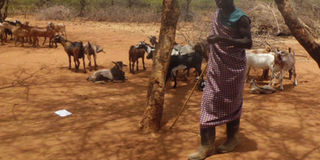Lokonoi abandoned cattle rustling to try mixed farming

Peter Lokonoi grazes his goats near his sugarcane plantation . Photo by Lominda Afedraru
The belief that people in Karamoja keep cattle as their only source of livelihood is no more.
This is attested by Peter Lokonoi, a model farmer who was pulled out of cattle raiding by experts from Food and Agriculture Organisation (FAO) after sensitising him about the importance of mixed farming.
Before 2012, Lokonoi, aged 45 a resident of Laboktom village in Amudat District, was among the notorious people who used to ambush anybody in search of money and raid cattle from neighbouring villages.
“Raiding cattle was a lifestyle for me because that was all I knew. But when FAO experts came around sensitising farmers about the importance of growing crops and keeping animals, I abandoned the warrior activity opting to engage in farming,” he says.
In 2012 he left the warrior lifestyle opting to start farming after learning about the advantages of mixed farming. The beneficiaries were asked to form farmer field schools, each with 30 members.
Lokonoi belongs to the Louta Nabokotom farmer field school where he is the chairperson.
Benchmarking
Lokonoi and his farmers’ group were taken for exchange visits to other districts such as Moroto and Napak to see how their colleagues were growing vegetables for commercial purposes.
He was determined and came back to put the same into practice and out of 30 members, others dropped off leaving them 15 members.
“Many of my friends in the group with whom we were trained became lazy and opted to do other petty jobs than farming but the 15 members were determined and we proceeded with mixed farming growing vegetables like cabbage, cow pea, onions, maize, beans and rearing animals. As a group we managed to purchase land where we are growing sugar cane which we sell the sugar cane and share the proceeds,” he adds.
In 2013, he embarked on growing cow pea, Sukuma wiki, tomatoes, onions and cabbages which he sold and out of the proceeds he kept purchasing goats. Now, he owns more than 70 goats and he has some cattle too.
Projects
In the group vegetable garden they use drip irrigation so they can grow the vegetables all year round.
He sells the vegetables in the local market in Amudat and sometimes in markets in Kenya.
The money is saved in the village saving scheme where the profits are shared at the end of the year.
“We used to grow maize inter planted with beans where we would realise little in harvests but now we plant in line and apportion separate land for beans and the harvest has improved,” Lokonoi says.
Alternative water source
Previously, there was water scarcity since most springs and rivers in Karamoja dry up in the dry season but Lokonoi is grateful to FAO for having constructed solar powered water tanks where the water is pumped from underground to fill a tank of about 10,000 litres capacity.
Lokonoi and farmers in surrounding villages use this water facility for irrigating their vegetable garden, for animals as well as human beings.
For the case of animals, a water collection point has been constructed and it allows between 10 and 20 cattle to drink water at ago but for goats, the number is more than 20. Animals are kept at collection kraal point next to the water facility and they are released according to the required number.
Benefits
The future is promising. “I can now afford to take my three primary school going children to school with ease,” Lokonoi says.
He has been able to purchase solar power system which he uses for lighting in his family house. “This is a major leap. I can now avoid bush fires which are so rampant in Karamoja during the dry season. Using fire as light can kill animals in kraals as well as destroy farms,” he says.
Lokonoi now has the privilege to avoid situations of starvation because his group members were sensitised about the importance of cereal banking where they keep maize grain, sorghum grain and millet grain in group granaries some of which are sold to cater for necessities such as treatment in case of sickness and some to cater for their food supplement in times of food scarcity.
Farming goes to Karamoja
There are other farmer groups in Moroto and Napak districts engaged in growing vegetables as a source of their daily income using drip irrigation from solar powered water tanks constructed at major group farm sites in every district in Karamoja region by FAO to address water challenge issues.
Joseph Tapem from Naligwe village in Napak District belonging to Lobora farmer field school is a beneficiary of vegetable growing.
He points out that previously water scarcity was a challenge but now with the solar powered water tank, his group is able to water the vegetables twice a day for purposes of achieving improved yields.
He has been growing cow pea, cabbages, onions, sukuma wiki and tomatoes for six years, which is sold in Matanyi market within the district.
Besides vegetable growing, the group has planted citrus and mangoes which will supplement to their daily income.
The group was given goats three per person and his goats have multiplied to more than 50 in number. This farm engagement has enabled him take his four primary school going children to boarding school.
The integrated farming initiative by FAO to change the live style of people like Lokonoi was under a four-year project funded by United Kingdom Department for International Development (DFID) worth $14 million. This covers animal health, climate change resilience and water management for farming, among others.




